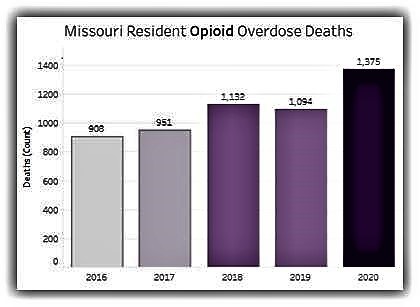JEFFERSON CITY – With 1,878 deaths, 2020 had the highest number of fatal drug overdoses to date in the state of Missouri – a 19% increase from 2019. 1,375 of these deaths involved opioids. Today, the Missouri Department of Health and Senior Services (DHSS) launched a new, interactive dashboard showing data regarding both fatal and nonfatal overdoses, where they occurred in the state and the demographic makeup of those who overdosed.
Following national trends, drug overdoses have become an epidemic in Missouri over the past decade. Missouri ranked 32nd in the nation for drug overdose death rates in 2020.
Among adults aged 18-44 in Missouri, drug overdose is the leading cause of death, and more than 70% of all drug overdose deaths in the state involve opioids. The opioid class of drugs includes heroin, fentanyl, methadone, morphine, oxycodone and many other prescription and non-prescription pain relievers.
“The opioid crisis is an issue only made worse by the COVID-19 pandemic,” said Paula Nickelson, DHSS Acting Director. “This is a health crisis that knows no bounds–it affects all genders, races and ages in both rural and urban communities. Our efforts at the state level to combat opioid misuse and overdose include monitoring and prevention strategies designed to improve data quality, inform decision making and implement targeted interventions.”

The new dashboard shows a sharp increase in recent years of deaths, from those involving heroin (with no synthetic opioids present) to deaths involving synthetic opioids. Synthetic opioids, including fentanyl and its analogs, were involved in 1,204 drug overdose deaths in 2020 in Missouri. The 2020 figure is nearly seven times higher than the 2015 count of 179 synthetic opioid-involved deaths.
In an effort to alter this trajectory, DHSS has several strategies and activities currently underway or in development. These efforts are supported through the Overdose Data to Action (OD2A) cooperative agreement with the Centers for Disease Control and Prevention (CDC) which began in 2019.
Data Monitoring
- Collect and disseminate timely Emergency Department data on all suspected drug, opioid, heroin and stimulant overdoses: Perform monitoring in Missouri’s Electronic Surveillance System for the Early Notification of Community-based Epidemics (ESSENCE) using case definitions for all drugs, opioids, heroin and stimulant overdoses.
- Collect and disseminate descriptions of drug overdose death circumstances using death certificates and medical examiner/coroner data: Collect data from death certificates and medical examiner/coroner reports and enter data into the State Unintentional Drug Overdose Reporting System (SUDORS).
- Implement Innovative Surveillance: Link records between two nonfatal data sources, ESSENCE and Patient Abstract System, on various overdose types to evaluate the relationship between overdoses reported with more real time data versus more comprehensive but lagged data.
Prevention Methods
- Prescription Monitoring Compliance: Conduct regulatory inspections on high-risk prescribers and outliers; seek regulatory actions and remedies; provide information and education to prescribers about CDC prescribing guidelines.
- State/local Integration Efforts: DHSS has established 16 current contracts with select local public health agencies to focus on opioid and illicit drug use prevention and response efforts.
oDHSS collaborated with the Missouri Department of Mental Health and provided funding to three local prevention centers to combat opioid misuse and overdose.
oThe DHSS Office of Minority Health responds to overdoses in the St. Louis area and provides resources to overdose patients regarding treatment services.
oDHSS held its inaugural Harm Reduction Conference in June of 2021 and is in the planning stages for the 2022 conference.
oDHSS is developing a second Missouri vulnerability assessment focusing on dual issues of opioid misuse and blood-borne infection.
oThe DHSS Bureau of HIV, STD and Hepatitis provides Harm Reduction 101 training and technical assistance to local public health agencies and community-based organizations.
- Linkages to Care: DHSS has supported contracted HIV Peer Navigators and other designated staff to attend the Missouri Credentialing Board Medication Assisted Recovery training, integrated the HIV Reduction 101 training into the HIV/Hepatitis C training and continues to look for professional certification opportunities to build system staff capacity.
- Public Safety Partnerships: The DHSS Bureau of Healthcare Analysis and Data Dissemination has established a linkage of opioid overdose mortality data with offenders released from the Missouri Department of Corrections. DHSS has a linkage with the Midwest High Intensity Drug Trafficking Area to review drug seizure data and compare with opioid overdose mortality data.
- Public Awareness: DHSS will launch a new media campaign based on most recent data to raise awareness of opioid misuse and overdose. DHSS has previously implemented three separate campaigns to focus on opioid awareness, harm reduction strategies and CDC Rx Awareness facets. The campaign targeted zip codes with the highest opioid mortality rates; these campaigns have been marketed on radio, billboards, at gas stations, across social media platforms and through other venues and platforms.
View the drug overdose dashboard at health.mo.gov/data/opioids, or visit Time2ActMissouri.com for more information or resources.
About the Missouri Department of Health and Senior Services: The department seeks to be the leader in protecting health and keeping people safe. More information about DHSS can be found at health.mo.gov or find us on Facebook and Twitter @HealthyLivingMo.
